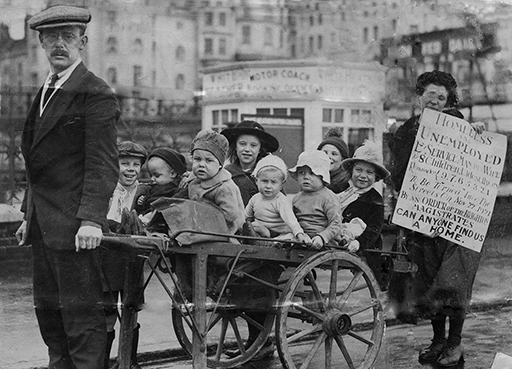The debt problem
You cannot spend your way out of recession or borrow your way out of debt.
This common sense mantra has been espoused by those on the right of the political spectrum in response to the economic crisis of 2008, such as the Tea Party movement in the USA. The alternative political position is captured in the T-shirt below, worn by supporters of the anti-cuts movement.
Rather than spending in a recession, the government orthodoxy (traditionally referred to as the ‘Treasury view’ or ‘sound finance’) has been to balance its budget by cutting expenditure. This ‘sound finance’ view, traditionally associated with the nineteenth-century Liberal Prime Minister William Gladstone, is not limited to recessions. It more generally states that the government budget should be balanced at all times (or in slight surplus so as to pay down past debt).
The balanced budget approach has been the cornerstone of the Conservative/Liberal Democrat coalition government since coming to power in 2010. With a target to balance the budget by 2016, it introduced a programme of severe cuts in government spending. In his 2010 emergency Budget, George Osborne proclaimed:
This is an emergency Budget, so let me speak plainly about the emergency that we face. The coalition Government have inherited from their predecessors the largest budget deficit of any economy in Europe, with the single exception of Ireland … That is why we have set a brisk pace since taking office.
The coalition government also argued that they inherited the largest level of debt incurred by a British government during peacetime. As shown in the box opposite, when the last Conservative/Liberal coalition was in power, led by Lloyd George (before he became a Keynesian), a similar austerity programme, known as the Geddes Axe, was implemented.
The Geddes Axe: a brief explanation

After the First World War, Britain was gripped by enormous debts and a growing sense of panic that the Government was hugely wasteful.
The national debt had risen dramatically from £677 million, about a quarter of the GDP, in 1910. By 1920 it was £7.81 billion, larger even than the country’s GDP. A vast civil service, that had come together to administer the war effort, was still operating at full capacity, while spending on education had increased substantially. Many of the middle classes complained how their tax bills had shot up.
The Government was under pressure to do something. The Times newspaper noted in 1922: ‘There are signs of an astonished realisation of the alarming bill for civil pensions that in a few years will be a millstone on the taxpayer’s neck.’
The Anti-Waste League, formed by Lord Rothermere, had put up candidates and won three by-elections during 1921.
David Lloyd George, the prime minister, acted by appointing a businessman Sir Eric Geddes to head the new Committee on National Expenditure, which was soon dubbed ‘The Great Axe’. It highlighted waste in all areas of public spending, including details such as there being a ratio of one cleaner for every vehicle in the Army. Between 1921 and 1922 it recommended economies totalling £87 million, about 10 per cent of the country’s entire GDP.
Though the cabinet only agreed to £52 million of cuts, these were enormous for the time and in the end, total cuts were larger than either of these figures. He was hailed a ‘superman’ by one leading businessman, but the axe hit some people very hard and led to a large reduction in social benefits, particularly secondary education.
The biggest cuts were in the Army and Navy. The defence budget was cut by 42 per cent in the space of one year. But other workers were hit too.
Civil Service numbers were cut by 35 per cent – mostly female staff hired during the war.
At the close of 1921, wage cuts averaging 8 shillings a week had been imposed on 6 million workers. This equates to a £58 fall in today’s money and led to growing anger against the government.
The cuts were driven by a Treasury desperate to keep a control of its debts, but they partly caused Britain’s woes in the 1920s – a period of far greater economic trouble for the country than it ever experienced during the 1930s. The General Strike in 1926 can, in part, be explained by the mounting resentment caused by the cuts, though some economists argue it helped Britain exit the vicious recession of 1919 to 1921 quicker than it might otherwise have done.
The Geddes Act, introduced by one of the great Liberal administrations, ironically gave impetus to a burgeoning Labour Party. The number of seats it held rose from 59 in 1918 to 142 in 1922, reflecting a new coalition across class lines. It went on to form its first administration in 1924.
It was in the aftermath of the Geddes cuts in the 1920s that Lloyd George and Keynes formulated their arguments as to why governments could spend their way out of recession. Keynes once said ‘When the facts change I change my mind. What do you do, sir?’ – a mantra that would equally apply to Lloyd George during this period. Keynes also argued that a government spending programme could be easily paid for, without threatening government finances.
Thus far this section has made reference to both a budget deficit and government debt. It is important to be clear about how these differ.
Government debt, also called the national debt, is the total amount of money owed by the government to all those from whom it has borrowed. It is a stock, that is, an accumulated amount, not an amount measured per period of time.
The primary budget deficit is the excess of government expenditure over tax receipts in a given time period, usually one year – so it is a flow. In any year when there is a deficit, the national debt will increase. If there is a budget surplus (tax receipts exceed expenditure), then the government may decide to use part of it to reduce its outstanding debt. If tax receipts exactly match government spending, then this is referred to as a balanced budget.

